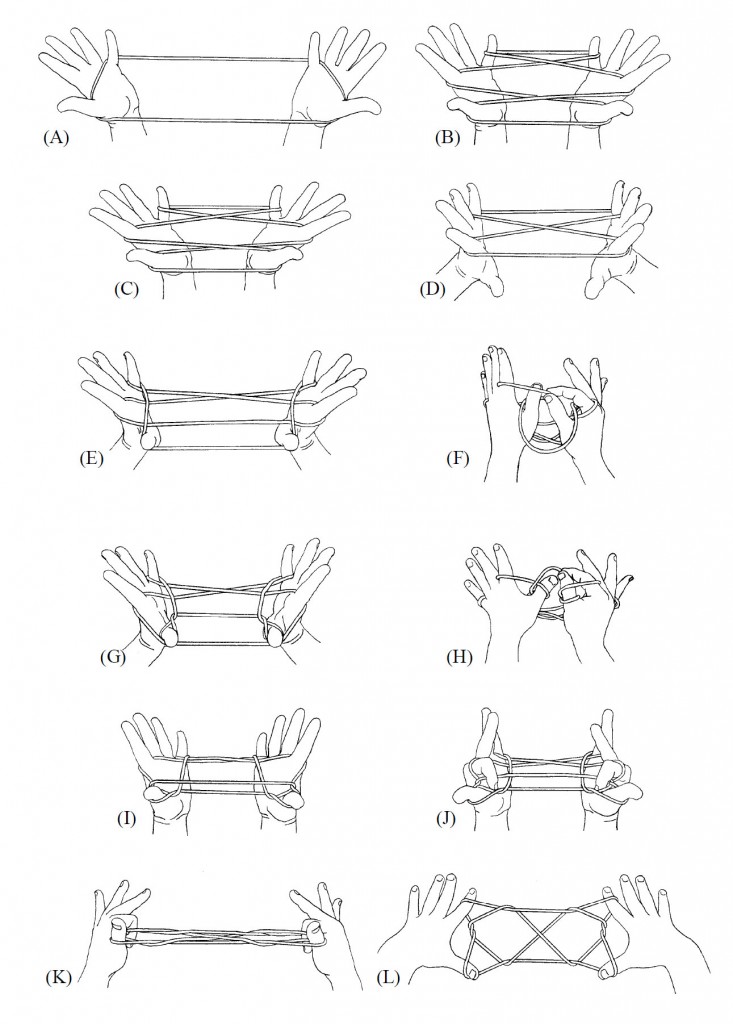Osage Two Diamonds – a simple two-loop system
Osage Two Diamonds was first described by Caroline Furness Jayne, who learned it from an Osage Indian.
Loom phase
- Begin with Position 1 (fig. A), followed by Opening A (fig. B). Note that in Opening A, the left palmar string is retrieved first. If the right palmar string is taken up first, you have what is called Opening B (fig. C).
- Drop the loop from your thumbs and pull your hands apart to generate the basic two-loop loom (fig. D).
Weaving phase
- With your thumbs, reach away from you, over three strings, and pick up the fourth string (the far little finger string) from underneath. Return the thumbs to their starting position (fig. E).
Extension Phase
- Use the thumb and index of your right hand to pick up the segment of the left near index string that lies between the left index and the left palmar string. Drop it over the left thumb (fig. F), then repeat on the right and separate the hands (fig. G).
- With the help of the right hand, navaho the left thumb loops (lift the lower loop over the upper loop and release it, fig. H). With your left hand navaho the right thumb loops and extend (fig. I). This move is named after the Navaho Indians (the Diné people), who use it frequently in making string figures.
- Turn the palms toward you and note the triangles formed between the thumbs and index fingers. On each hand, place the index finger into this triangle and press it against the palm (fig. J).
- Slide the loop off each little finger (use the right little finger to slide the loop off the left little finger and vice versa) and separate the hands to absorb the slack (fig. K). Note: The string concealed beneath your bent index finger will become the upper frame string of the design — don’t drop it.
- Rotate and open your hands away from you as if you were getting ready to catch a volleyball thrown shoulder-high. As you roll your hands, your thumbs will point toward you, then down, then toward each other; your index fingers will point away from you and then up as you straighten them. The result is Osage Two Diamonds (fig. L).
For about 95% of all students, one or both strings fall off the index fingers during the first few tries. i remind them that practice makes perfect, and that with practice, the hands will learn to dance smoothly as the figure is formed.
SIMPLE VARIATIONS OF OSAGE TWO DIAMONDS
Once my students have mastered Osage Two Diamonds, i teach them how to vary the design by twisting some or all of the loops of the two-loop loom (fig. D). The results are one diamond, three diamonds, or four diamonds.
One Diamond
Loom Phase: same as Osage Two Diamonds
Weaving Phase
- Bring the hands together, and with the left thumb and index finger grasp both strings of the right index finger loop (near the base of the finger). Twist the right index finger toward you, down, away, and back up to where it started, then let go of the strings held by the left thumb and index. In a similar fashion, twist the right little finger loop a full 360º toward you.
- With your thumbs, reach away from you, over three strings, and pick up the fourth string (the far little finger string) from underneath. Return the thumbs to their starting position.
Extension Phase: Same as Osage Two Diamonds.
The result is One Diamond
Three Diamonds
Loom Phase: same as Osage Two Diamonds
Weaving Phase: Same as One Diamond, but twist the left index and left little finger loops a full 360º towards you.
Extension Phase: Same as Osage Two Diamonds.
The result is Three Diamonds.
Four Diamonds
Loom Phase: same as Osage Two Diamonds
Weaving Phase: Same as One Diamond, but in addition to twisting the right index and right little finger loops, also twist the left index and left little finger loops (in other words, twist all four loops a full 360º toward you).
Extension Phase: Same as Osage Two Diamonds.
The result is Four Diamonds.
Variations with Opening B
i also encourage my students to make all of the above starting with Opening B. The results are rather surprising — One Diamond gives Three Diamonds and Three Diamonds give One Diamond (with minor differences in string crossings).

